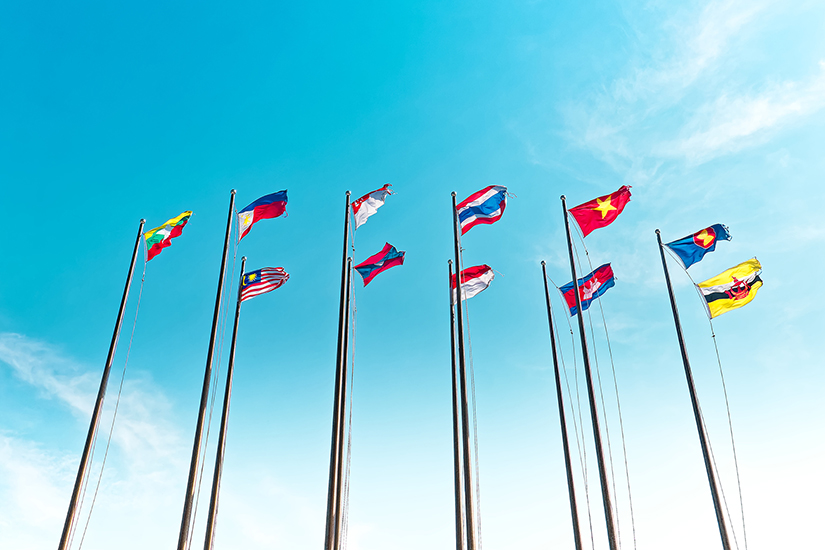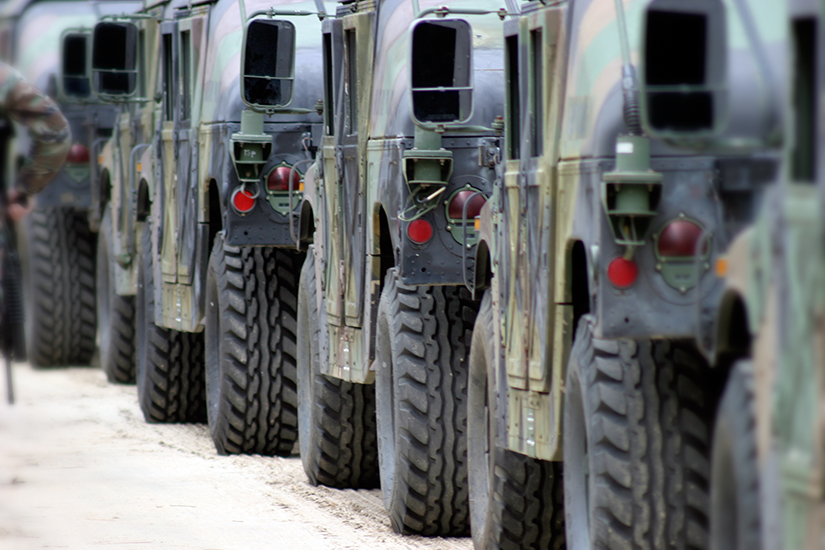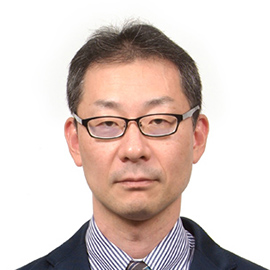The year 2023 marked the 50th anniversary of Friendship and cooperation between Japan and the Association of Southeast Asian Nations (ASEAN). Over the last half-century, the relationship between Japan and ASEAN has developed and matured. Japan has “made every effort to build up ‘heart to heart’ relations of mutual confidence and trust with ASEAN Member States and committed itself as an equal partner to building peace and prosperity in the region.”[1] With Japan’s increasingly close partnership with ASEAN and a more diverse and multifaceted relationship, there has also been an expansion and deepening of cooperation in the security field against the backdrop of growing complexity in the East Asian strategic environment. This commentary focuses on Japan’s security policy on ASEAN, examining historical and future approaches to Japan-ASEAN cooperation.

The historical development and expansion of Japan-ASEAN Cooperation
ASEAN is an important region for Japan. Maintaining and strengthening cooperation with this region has always been a key issue in Japanese foreign policy, and Japan has spent many years since the postwar era working to develop its bilateral relationships with ASEAN countries, as well as its multilateral relationship with ASEAN. During the initial stage of these partnerships, which grew from negotiations on war reparations, relationships were focused primarily on economic cooperation. As economic cooperation deepened, these relationships expanded to include political cooperation. Today, the Japan-ASEAN partnership has developed into a more comprehensive relationship that includes security: particularly the handling of non-traditional security issues.[2]
Security cooperation between Japan and ASEAN has developed in the context of China's rise in power and its growing influence in the ASEAN region. As China’s influence in the region has grown, Japan has endeavored to build more comprehensive relationships of cooperation with ASEAN, including security cooperation, to compensate for the relative decline in its presence in the region. Japan’s security cooperation with ASEAN also served to bolster Japan’s own security. By promoting cooperation with ASEAN, which is directly confronted with China’s assertive stance in the South China Sea, Japan, confronting China’s assertiveness in the East China Sea, has sought to establish a concerted response to China’s maritime expansion.[3]
Today, China’s influence in the ASEAN region has become overwhelming, threatening to surpass even that of the United States.[4] With the US and China jousting for supremacy in ASEAN, how can Japan be a relevant partner for the region? The key here is “trust.” The mutual perceptions of trust built up over many years of cooperation are a vital asset for Japan in its relations with ASEAN countries.[5] Japan must find a way to leverage this trust to formulate and implement policies that are not only in its own interests but also benefit the ASEAN region.
Vision and Practice of Japan-ASEAN Security Cooperation
The vision of a “Free and Open Indo-Pacific” (FOIP) is the mainstay of Japan’s Indo-Pacific strategy today. The content and direction of the FOIP vision have been progressively adjusted based on the reactions shown by ASEAN — which Japan perceives as its main partner in pursuing this vision — before settling into their current form.[6] The rule of law, the freedom of navigation, and improving connectivity, designated the “three pillars of FOIP,” together with commitment to peace and stability, translate to the defense policies of securing the stable use of major sea lanes, preventing contingencies, and contributing to peace and stability through active engagement in the region. Japan’s Ministry of Defense and the Self-Defense Forces are pursuing cooperation and exchanges among people, capacity building programs, cooperation and exchanges among troops, and defense equipment and technology cooperation to achieve these policy goals.[7]
The Vientiane Vision embodies the FOIP approach in terms of defense cooperation with ASEAN. This vision, a guiding principle for Japan’s defense cooperation with ASEAN, was declared by Defense Minister Inada at the second ASEAN-Japan Defense Ministers’ Informal Meeting held in Vientiane, Lao PDR, in 2016.[8] The main focus of the Vientiane Vision was on stronger cooperation with ASEAN countries to maintain order in the region based on the rule of law, bearing in mind China’s maritime expansion.[9]
In 2019, the Vientiane Vision was updated based on the FOIP and the ASEAN Outlook on the Indo-Pacific (AOIP). Vientiane Vision 2.0 was announced by Defense Minister Kono at the fifth ASEAN-Japan Defense Ministers’ Informal Meeting, held the same year.[10] This new version upheld “Heart-to-Heart,” “Equal and Open” cooperation, drawing on the spirit of the 1977 Fukuda Doctrine, Japan’s basic policy on ASEAN. Emphasizing initiatives to contribute to ASEAN’s “centrality, unity and resilience,” Vientiane Vision 2.0 indicated an even closer commitment to the philosophy and standpoint of the region.[11]
The Vientiane Vision enumerates a variety of methods for cooperation. Among these, Japan’s capacity building projects have progressively achieved results for over a decade since 2012. These projects are not exclusively limited to the ASEAN region. However, of the 16 countries supported so far, nine are ASEAN countries, and ASEAN is the central focus of these projects, with over 40 training sessions and seminars conducted in Vietnam, for example.[12]
Recent years have seen increasingly vigorous defense equipment and technology cooperation. Japan has progressively signed defense equipment and technology cooperation agreements with countries in the ASEAN region (with the Philippines in 2016, Malaysia in 2018, Indonesia and Vietnam in 2021, and Thailand in 2022), with cooperation on equipment and technology expected to promote cooperation in humanitarian assistance and disaster relief (HA/DR) and maritime security. The transfer of equipment is progressing in the case of the Philippines, specifically, where TC-90 trainer aircraft from the Japan Maritime Self-Defense Force, UH-1H multipurpose helicopters from the Ground Self‐Defense Force, and air surveillance radar systems manufactured by Mitsubishi Electric Corporation have been transferred so far.[13] Equipment is in high demand in the ASEAN region, and Japan-ASEAN cooperation on equipment and technology is likely to evolve further in the future through progressive institutionalization.
Bilateral defense cooperation with the Philippines is showing especially significant progress in the context of China’s maritime expansion. The first Japan-Philippines Foreign and Defense Ministerial Meeting (“2+2”) was held in April 2022. Discussions commenced towards the signing of a reciprocal access agreement (RAA) and acquisition and cross-servicing agreement (ACSA), aimed at more smoothly facilitating joint exercises between Japan’s Self-Defense Forces and the Philippines military.[14] The conclusion of visiting forces agreement between the two countries has also become a possibility.[15]

In terms of maritime security, the Japan Coast Guard is also undertaking cooperation in the region, with the launch of the Mobile Cooperation Team (MCT) in 2017. In addition to the support provided by the MCT for the enhancement of various capacities related to maritime security in ASEAN countries, such as maritime law enforcement, search and rescue of maritime accidents, and oil spill response, the Japan Coast Guard Academy also accepts maritime security officials from each nation into its Maritime Safety and Security Policy Program, which provides education aimed at enhancing maritime security capabilities.[16] The Japan Coast Guard also uses the ODA framework to provide patrol vessels to the Philippines and Vietnam.[17]
Cooperation for the Future
In the National Defense Strategy announced in December 2022, Japan set forth its intention of pursuing cooperation with ASEAN through a multilateral framework, while also engaging in strategic dialogue, strategic port calls, joint exercises, defense equipment cooperation, and capacity building assistance on a bilateral level.[18] This language seems to indicate an intention of maintaining the current basic selection of cooperative efforts into the future by raising their frequency and level of implementation. For equipment cooperation, in particular, the Official Security Assistance (OSA), a new assistance framework announced recently by the Japanese government, indicates that Japan is considering the provision of materials and equipment to countries such as the Philippines and Malaysia.[19]
In February 2023, the Expert Panel for the 50th Year of ASEAN-Japan Friendship and Cooperation released its report on the nature of cooperation for the next half-century. One of the main points of this report was its emphasis on the perception that ASEAN, a growing presence in the international community, was no longer simply a recipient of assistance and aid but was now a partner of Japan, jointly engaged in tackling issues common to both.[20] Indeed, going forward, security cooperation must be founded on the recognition of ASEAN as an “equal partner” and a shift in policy and content from “assistance” to “cooperation.” Respect for the integrity of sovereignty and territory and the refusal to accept any attempt to change the status quo by force are principles commonly acknowledged by Japan and ASEAN (as well as Europe and the United States). Security cooperation should begin from this common understanding.[21]
The opinions expressed in this review are the author’s own and do not reflect the official views of the organizations with which he is affiliated.

(2023/08/24)
Notes
- 1 Ministry of Foreign Affairs, “The 50th Year of ASEAN-Japan Friendship and Cooperation,” April 6, 2023.
- 2 Tomotaka Shoji, “Pursuing a Multi-dimensional Relationship: Rising China and Japan's Southeast Asia Policy,” Jun Tsunekawa, The Rise of China: Responses from Southeast Asia and Japan, NIDS Joint Research Series No.4, 2009, p.155.
- 3 Tomotaka Shoji, “Japan’s Security Cooperation with ASEAN: Pursuit of a Status as a ‘Relevant Partner’,” NIDS Journal of Defense and Security, No. 16, December 2015, p. 98.
- 4 ISEAS Yusof Ishak Institute, The State of Southeast Asia 2023: Survey Report, pp. 24-27.
- 5 Ibid., p. 50.
- 6 Kei Koga, “Japan’s ‘Free and Open Indo-Pacific’ Strategy: Tokyo’s Tactical Hedging and the Implications for ASEAN,” Contemporary Southeast Asia, vol. 41, no. 2, August 2019, pp. 295-299.
- 7 Ministry of Defense, “Free and Open Indo-Pacific: Japan Ministry of Defense’s Approach”
- 8 Ministry of Defense, “Vientiane Vision: Japan’s Defense Cooperation Initiative with ASEAN.”
- 9 Ippeita Nishida, “Japan’s Defense Diplomacy with ASEAN: What is the Vientiane Vision?”
International Information Network Analysis (IINA), August 30, 2018. “Philippines, U.S. Announce Four New EDCA Sites,” February 1, 2023. - 10 Ministry of Defense, “5th ASEAN-Japan Defense Ministers’ Informal Meeting (Overview),” November 17, 2019.
- 11 Ministry of Defense, “Updating the ‘Vientiane Vision: Japan’s Defense Cooperation Initiative with ASEAN.’”
- 12 Ministry of Defense, “Capacity Building.”
- 13 Acquisition, Technology & Logistics Agency, “Defense Equipment and Technology Cooperation.”
- 14 Ministry of Defense, “1st Japan-Philippines Foreign and Defense Ministerial Meeting (‘2+2’),” April 9, 2022.
- 15 “The President of the Philippines Open to Concluding a Visiting Forces Agreement (VFA) with Japan,” February 13, 2023.
- 16 Japan Coast Guard, “Cooperation and collaboration with the coast guard agency of each country.”
- 17 Ministry of Foreign Affairs, “Provision of Yen Loans to the Philippines (Advance Notice),” September 6, 2016, “Preliminary Assessment Based on Policy Evaluation,” June 7, 2017.
- 18 Ministry of Defense, “National Defense Strategy,” December 16, 2022, p.16.
- 19 “Policy Decision on ‘OSA,’ Security Assistance for Comrade Countries: Japanese Government Considering Four Countries Including the Philippines,” Asahi Shimbun, April 5, 2023.
- 20 Ministry of Foreign Affairs, “Report of the Expert Panel for the 50th Year of ASEAN-Japan Friendship and Cooperation,” February 3, 2023, p.4.
- 21 “The Rising Presence of the Global South: Why ASEAN Doesn’t Exclude Russia,” Asahi Shimbun, March 28, 2023.

